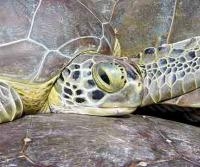SOS of the Atlantic Green Turtle
Submitted on 20 July 2006 - 3:54pm
This article is reproduced by CienciaPR with permission from the original source.

By Fernando Torres / Special for El Nuevo Día
endi.com
Probably to some culebrenses, is no surprise to hear that something strange is happening to the green turtles (Chelonia mydas), or peje blanco (the way they are called in Puerto Rico), in the coasts of Culebra. It’s something that does not make them look as pretty and majestic as they usually are.
It’s the growth of numerous warts and tumors all over the body of this species.
Sometimes they are so many and so big that they impede the from seeing, eating or swimming, and in many occasions make the turtles get tangled in fishing nets where they die asphyxiated.
What is causing this our pejes blancos?
Pejes blancos of Culebra are suffering of what is known in veterinary medicine as green turtle cutaneous fibropapilomatosis (FP), that is, fibrous warts. Although the disease has been well studied since its first world-wide report about 50 years, still nowadays many questions remain about it.
Most of scientists agree that a virus of the herpes family plays an important role in the development of the disease; nevertheless this has not been proved with absolute certainty.
This virus is totally different from the papiloma virus that causes warts in humans. In fact, human cases of infection with the FP virus have never been reported.
Turtles with FP have been reported sporadically throughout the coasts of the Main Island of Puerto Rico for many years, nevertheless in Culebra the first documented sightings date approximately to 1980.
Headed by investigator Carlos Diez, scientists of the Department of Natural and Environmental Resources of Puerto Rico (DRNA) began to collect detailed information on these animals by mid-1990. These observations demonstrated that most of the affected animals live in the bay of Puerto de Manglar.
In contrast, there are almost no animals affected in waters of the adjacent island of Culebrita.
This particular distribution between geographically close areas has also been observed in places like Hawaii and Florida.
Moreover, there are many ecological and geographic similarities between the affected locations world-wide.
Due to this, many scientists have suggested that an environmental factor closely related to the development of disease exists, and that its possible that the green turtles are serving as “interpreters” of the environmental changes to us. These environmental changes could very well have a negative impact in other organisms of the ecosystem including fish and humans.
From this stems the importance of paying a little more attention to our green friends.
The importance of studying and of knowing this disease better is not to motivate efforts to protect a threatened species, but that additional investigations could help to know how to face other diseases.
Studying the virus mechanism to cause the disease, it is possible to know how similar viruses cause disease in other animals including human beings.
In order to know more on this enigmatic disease and its impact in Culebra, since 2003 investigators of the DRNA together with the US Wild Life and Fishing Service and local volunteers, united forces with veterinary scientists from the Veterinary Medicine School of the University of Georgia.
Since then our green friends have been monitored and closely examined.
Investigators of this virus receive funding support from Morris Animal Foundation, Gerladine R. Dodge Foundation and private companies like Remote Vet Inc, IDEXX Laboratories Inc. and United Parcel Service (UPS), who transports material and equipment to the Island free of cost.
For more information visit Culebra Conservation Medicine Project's website







